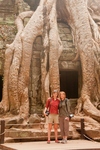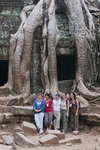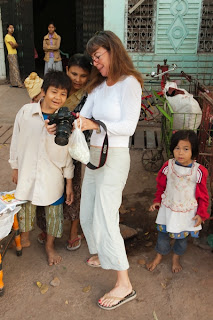Everyone’s heard the saying ‘A
picture is worth a thousand words.’ We wouldn't spend so much time capturing
and sharing our images if we didn't believe in the power of images to
communicate. The trouble with photography is, managing the effects we as
photographers have on our subjects and their environments whether it be ancient
historical sites, natural wonders, people or wildlife. Photographs don’t happen
in a vacuum; photographers have to interact with their subject and their
surroundings.
Although this topic is rather
large, and filled with controversy, there are some common ethical problems that
arise in travel photography which provide some perspective on how you may want
to address them on your own adventures.
Ancient Historical Sites
Jeff Morgan, the owner of the
Global Heritage Fund, was recently quoted, saying ‘No one should be allowed to
walk on 1000 year old stones.’ Now, I doubt that he literally wants the great
cathedrals of Europe to be closed to the public, but he has a good point. Many
heavily trafficked areas of landmark temples like Angkor Wat have started to
wear down to the point where they are actually losing their original shape and
grandeur – authorities have started to protect them with walkways.
Obviously not just
photographers, but the overall onslaught of tourists is responsible;
unfortunately, it is us photographers that pay the price for the new ropes,
railings and signage that are necessary to control the damage. If simple signs
were adhered to, then it’s possible that photo opportunities could be left
intact for us photographers. Obviously that’s just wishful thinking. The image
below shows the classic view of the famous tree growing through Ta Prohm in the
Angkor Temple complex. Unfortunately this shot isn't there anymore… The
following image shows how the scene has been fenced off with a platform and
railing due to the amount of tourists who used to stand on the tree roots and
stones to have their photographs taken; this changes the scene entirely for
landscape photographers. All too often we see photographers ignoring the
efforts of most developing countries to protect their heritage sites; killing
the opportunity for future photographers to capture original photographs of
world famous landmarks.
Photographing Children
There are thousands if not
millions of opportunities around the world to photograph people doing something
unique or wearing interesting clothing or with amazing faces. There is nothing
more entertaining than casual people or street photography. In saying this,
plenty of harm can result as well. Firstly, we’ll start with kids. In developing
countries especially, many photographers pay small children to take their
photograph; more times than not, those kids should be in school or studying and
instead they have been dressed up and sent out to beg. This can quickly become
their way of life once they become a source of revenue for their families.
Something that is almost as
bad as money, is giving them lollies/sweets. Most of the children who have not
been pushed into begging love having their photos taken and would not like or
ask for anything in return. Showing them the image you have taken for them on
the back of your camera is more times than not, icing on the cake for them.
If you feel you should give
the children anything for their photograph, lean more towards things such as
pencils or other school supplies. Or an even better alternative is to look for
controlled ways to get photo opportunities. Visit monasteries, nunneries or
schools and donate money to the institution while also giving the students
pencils or school books.

Paying adults to take their picture is more complicated than paying children. Obviously there isn’t anything wrong with earning a living by modelling but in cases where the money encourages customs which have outlived their usefulness to continue for sakes of tourism, the photographs no longer justify for social cost.
Wildlife
Everyone would be familiar
with scenes of harassment of wildlife, with photographers flushing nesting
birds to get photographs of chicks or pursuing animals and making it difficult
for them to eat. These are no-brainer bad ideas but there are other less
obvious examples of how photographing wild animals can cause them trouble.
If you hear stories from
anyone who stayed right on top of a hunting animal, ask them whether they had
thought through all the consequences down the road.
For some people, there is
nothing more exciting than watching predators hunt, whether it be a pack of
wild dogs, a pride of lions or a lone leopard; the way they stalk and isolate
their prey and the wild chase that follows, is often the highlight of an
African safari. These animals are not so dumb. Many have learned to look for
tourists or trucks and assume predators are close by. The guides have been
trained to back off once a hunting animal gets serious enough to stalk their
prey. Obviously, once the prey has seen their predator, the game is afoot and
there are photographers everywhere; but giving the animals some space at the
right time, we help to avoid stressing them and have helped to ensure they won’t
eventually avoid all trucks in the future.
Unintended Consequences
A rare treat for
photographers is photographing Meerkats. Some type of habituation is a must for
good photo opportunities as Meerkats, when first encountered, aren't very
tolerant of people. Having a person near, them most of the time, scares the
males that are out looking for nearby Meerkat families to breed with. The
guides were smart enough to realise that the animals were getting scared, and
learnt to back off when that family is looking for nearby Meerkats; even though
this lead to a fall in their business short term.
These are just a few examples
of times when a photographer will have to make some ethical decisions. There are
new situations everyday as our environment continually changes and the number
of tourists and travelling photographers continues to increase.









No comments:
Post a Comment